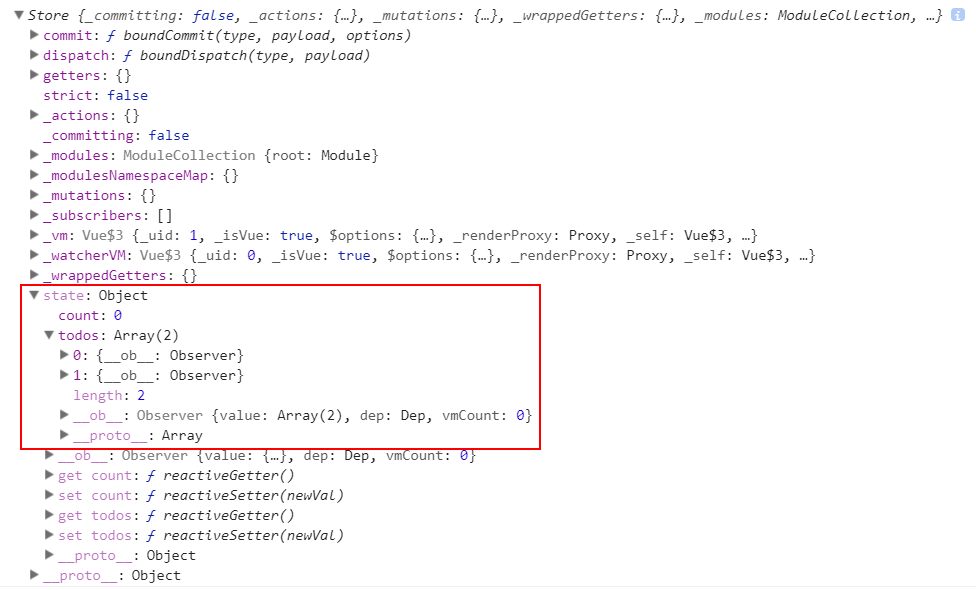第二章 Module类
Module类定义在VUEX源码的106 ~ 168 行,我们来具体看看它的内容。
2.1 成员属性
Module类的成员属性有四个,分别是:
- runtime。表示是否运行时,类型Boolean。
- _children。存储该模块的直接子模块,类型Object。
- _rawModule。存储该模块自身,类型Object。
- state。存储该模块的state,类型Object。
其源码定义在106 ~ 112 行:
var Module = function Module (rawModule, runtime) {
this.runtime = runtime;
this._children = Object.create(null);
this._rawModule = rawModule;
var rawState = rawModule.state;
this.state = (typeof rawState === 'function' ? rawState() : rawState) || {};
};
该类的定义无特殊之处,但从中我们可以看出,定义模块的state时,并不一定需要它是一个对象,它也可以是返回一个对象的工厂函数。因为从代码的执行来看,当state属性的值是一个函数时,会把这个函数的执行结果作为state。这一点在官方文档中是没有提及的。
我们可以通过下面这个例子来证明:
const store = new Vuex.Store({
state() {
return {
count: 0,
todos: [
{ id: 1, text: '...', done: true },
{ id: 2, text: '...', done: false }
]
}
}
})
console.log(store)
其输出结果如下:
2.2 原型函数
Module原型上分别定义了:
- 操作_children属性的addChild、removeChild、getChild、forEachChild四个方法。
- 操作_rawModule属性的update、forEachGetter、forEachAction、forEachMutation四个方法。
我们来分别看一看这几个方法的实现。
2.2.1 Module.prototype.addChild方法
addChild方法定义在VUEX源码的120 ~ 122 行,它的实现比较简单,就是将模块名称作为key,模块内容作为value定义在父模块的_children对象上:
Module.prototype.addChild = function addChild (key, module) {
this._children[key] = module;
};
2.2.2 Module.prototype.removeChild方法
removeChild方法定义在VUEX源码的124 ~ 126 行,它的实现也比较简单,就是采用删除对象属性的方法,将定义在父模块_children属性上的子模块delete:
Module.prototype.removeChild = function removeChild (key) {
delete this._children[key];
};
2.2.3 Module.prototype.getChild方法
getChild方法定义在VUEX源码的128 ~ 130 行,它的实现也比较简单,就是将父模块_children属性的子模块查找出来并return出去:
Module.prototype.getChild = function getChild (key) {
return this._children[key]
};
2.2.4 Module.prototype.forEachChild方法
forEachChild方法定义在VUEX源码的145 ~ 147 行,它接受一个函数作为参数,并且将该函数应用在Module实例的_children属性上,也就是说会应用在所有的子模块上:
Module.prototype.forEachChild = function forEachChild (fn) {
forEachValue(this._children, fn);
};
可以看到forEachChild 方法实际上是调用了另外一个辅助函数forEachValue,这个函数接收Module实例的_children属性以及forEachChild 方法的fn参数作为参数。它实际上是遍历_children对象,并将value和key作为fn的参执行fn。它定义在VUEX源码的87 ~ 92 行,我们来看看它的实现:
/**
* forEach for object
*/
function forEachValue (obj, fn) {
Object.keys(obj).forEach(function (key) { return fn(obj[key], key); });
}
2.2.5 Module.prototype.update方法
update方法定义在VUEX源码的132 ~ 143 行,它接收一个模块,然后用该模块更新当前Module实例上的_rawModule属性。更新的内容包括_rawModule的namespaced、actions、mutations、getters:
Module.prototype.update = function update (rawModule) {
this._rawModule.namespaced = rawModule.namespaced;
if (rawModule.actions) {
this._rawModule.actions = rawModule.actions;
}
if (rawModule.mutations) {
this._rawModule.mutations = rawModule.mutations;
}
if (rawModule.getters) {
this._rawModule.getters = rawModule.getters;
}
};
2.2.6 Module.prototype.forEachGetter方法
forEachGetter方法定义在VUEX源码的149 ~ 153 行,同forEachChild方法原理类似,forEachGetter方法接受一个函数作为参数,并且将该函数应用在Module实例的_rawModule属性的getters上,也就是说会应用在该模块的所有getters上:
Module.prototype.forEachGetter = function forEachGetter (fn) {
if (this._rawModule.getters) {
forEachValue(this._rawModule.getters, fn);
}
};
可以看到forEachGetter 方法实际上是也调用了另外一个辅助函数forEachValue,这个forEachValue函数前面已经介绍过,这里就不再赘述。
2.2.7 Module.prototype.forEachAction方法
forEachAction方法定义在VUEX源码的155 ~ 159 行,同forEachChild、forEachGetter 方法原理类似,forEachAction方法接受一个函数作为参数,并且将该函数应用在Module实例的_rawModule属性的actions上,也就是说会应用在该模块的所有actions上:
Module.prototype.forEachAction = function forEachAction (fn) {
if (this._rawModule.actions) {
forEachValue(this._rawModule.actions, fn);
}
};
2.2.8 Module.prototype.forEachMutation方法
forEachMutation方法定义在VUEX源码的161 ~ 165 行,同forEachChild、forEachGetter、 forEachGetter 方法原理类似,forEachMutation方法接受一个函数作为参数,并且将该函数应用在Module实例的_rawModule属性的mutations上,也就是说会应用在该模块的所有mutations上:
Module.prototype.forEachMutation = function forEachMutation (fn) {
if (this._rawModule.mutations) {
forEachValue(this._rawModule.mutations, fn);
}
};
由于forEachChild、forEachGetter、 forEachGetter、forEachMutation方法类似,所以我们这里仅以forEachMutation方法举一个例子,说明它及其实际执行者forEachValue的工作原理:
var options = {
state() {
return {
count: 0,
todos: [
{ id: 1, text: '...', done: true },
{ id: 2, text: '...', done: false }
]
}
},
mutations: {
increment (state) {
state.count++
},
increment1 (state) {
state.count++
}
}
}
var moduleIns = new Module(options)
moduleIns.forEachMutation(function (value, key) {
console.log(`mutations key is : ${key}`)
console.log(`mutations value is : ${value}`)
})
这里我们只是为了描述其原理,所以上述例子仅仅只是输出了motations的key和value,实际的使用场合会比这复杂的多,我们来看看上述例子的输出结果:
mutations key is : increment
mutations value is : increment(state) {
state.count++
}
mutations key is : increment1
mutations value is : increment1(state) {
state.count++
}